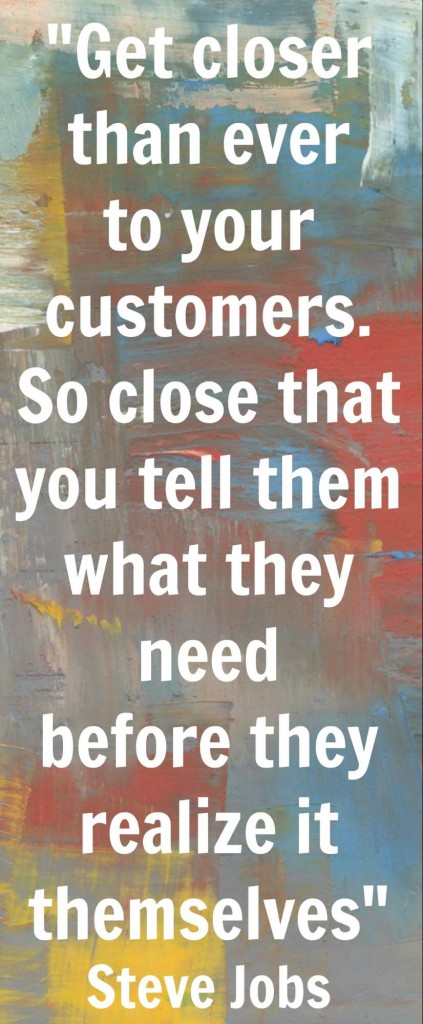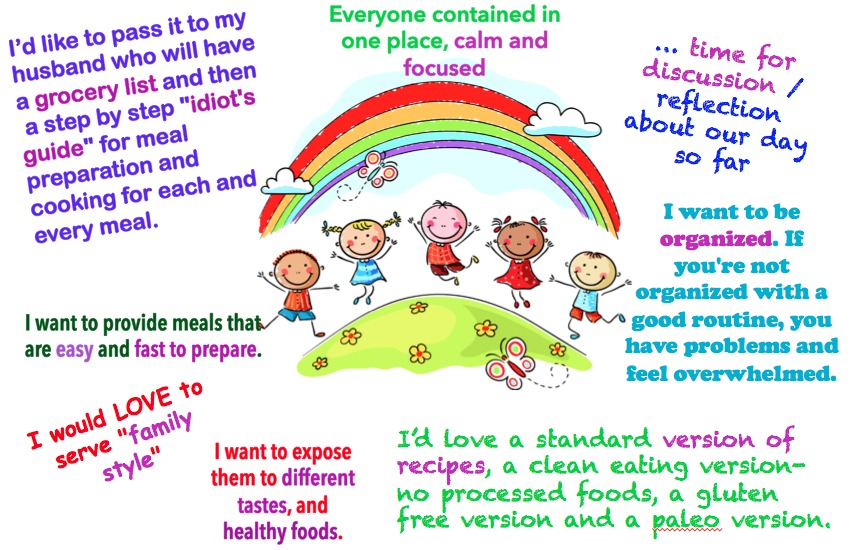
Let me ask you a question.
Where do you love to shop?
My personal favourite is a tiny candy store on the corner of a tiny street in my home town. I go back there every time I visit, and have done for the past fifty years.
Why there, when I could have chosen any number of high end places, or local high street stores?
Simple. Personal service.
Anne and Bill, the owners of that store, have known me for years. They know my name, and the names of my family. They knew when I was young that I loved red licorice and Now and Later chews (does anyone even make red licorice any more?). They knew that in my teen years I moved on to Chunkies and Almond Joy, and in my 20s settled on peanut M&Ms.
These days, when I go into the store, they have my favorite dark chocolate ready before I even have to ask.
And that is the secret to great customer service. Not just good – great.
Knowing your ideal customer.
Knowing what they want, recognizing that their tastes will change with the passing of time. Knowing where they are on their journey. Knowing how to meet their evolving needs with exactly what they’ve been looking for.
Ideally, something they’ve not been able to find anywhere else. Something you can provide.
That’s what creates a loyal customer. And that’s where we, as solopreneurs, have the advantage over large corporations.
Know what your customers want most, and what your company does best. Focus on where these two meet. – Kevin Stirtz
Tweet This
Know what your customers want most, and what your company does best. Focus on where these two meet. – Kevin Stirtz
Because yes, I could shop in Bloomingdale’s. They have a great range of products. Their customer service is efficient, and polite. The same goes for any of the large stores.
But do they know me? No. Do they stock products which meet my specific needs and which I’ve been searching for forever? Maybe – but probably not.
Do they know enough to get my dark chocolate out as soon as they see me coming? Nope. That’s why my little candy store wins every time.
So let’s break this down into stages, and apply it to your business.
Why Is It Important?
You’ve heard it before. Good businesses are always customer focused. But for many businesses, that focus begins in the wrong place. They focus on service after the customer has chosen and bought a product. That’s just not enough.
Knowing who your customer is and what they want from your business long before they buy, should form the basis of everything you do, every product you promote.
After all, if you have no idea who they are and what their problems or needs are, how are you going to decide what to sell them?
You can’t. You’re shooting in the dark. You’re giving your customer what you think they want. Which is not always the same as what they actually do want.

Don’t make that mistake. Your customer focus starts right at the beginning, ideally before you write anything for your online business. The more you focus on your customer, the more you learn what solutions they’re asking you to provide. The more you provide those targeted solutions, the greater your success will be.
It’s not just a matter of knowing your customer, though. You need to think about your ideal customer.
Who do you want to do business with? Who do you enjoy talking to? Who can you relate to?
In our personal life, none of us want to spend time with people we don’t like. Why would we want to do that in our business life?
Those customers who don’t fit with your ideal are more likely to take up more of your time. And your time is precious.
If they’re not a good fit for your business and the products you sell, they’re far more likely to complain.
So it’s not just a good idea for your customer’s sake. It’s necessary for your own well-being.
Isn’t it better to sell to as many people as possible, though? Surely you’ll sell more products that way rather than limiting the numbers you talk to?
Nope.
Selling to a wide group is likely to mean more of a mismatch. And a mismatch is likely to mean complaints – not just about products. For your online business – your website – it may mean more people ‘bounce’ away from your site, more quickly. Which is not good for your search engine rankings.
What Exactly Do You Need to Know?
Most “gurus” will tell you to create a demographic customer profile: gender, age, location, culture, number of children / grandchildren, disposable income. All of which is important. It will inform the way you position your website.
You’d write in a different style for a young, stay-at-home mom than you would for a retired grandparent, for example. And they’d both be different from a website targeting middle-aged business people.
So audience demographics are important. But they’re not the most critical part of learning who your ideal customer is.
The most critical issue is what they’re looking for when they visit your website.
Finding out is a three step process.
Step 1: Identify the problems, needs or desires your potential audience has. Which solutions have they tried before they reached you?
Step 2: Ask yourself “Why me? Why my website? Why my product?” Why should they choose you, of all the thousands of online businesses out there? What solutions can you offer which make you stand out from the rest?
Step 3: Solve their problems! Meet their needs! Position yourself so that they want to come back to visit time and again. Think of your product – whether that’s high quality information or a physical product – not as a product, but as a way of ensuring customer satisfaction at any point in their journey.
Which brings us to another point …
This is not a static, once-and-for-all, analysis.
A customer is not an avatar. She’s a living, breathing person with her own life into which, hopefully, you will be invited.
And that life progresses.
Your customers aren’t “prospects” or “personas,” but people on a journey.
Tweet This
So you might solve their first problem for them, but where are they going next?
Knowing that is the secret to keeping the relationship alive. Not a one-off visit to your website, but a relationship developing over many visits. Not a purchaser of one product, but a satisfied customer who knows you understand their needs and trusts you to meet them.
Simple, right?
No?
OK – let’s look at a concrete example.
Supposing your online business is about cycling. The niche you want to concentrate on is retired women returning to cycling as a way of keeping fit.
 Let’s call your ideal customer Betty. Betty first comes to your website because she wants reassurance about safety. The roads are so much busier these days. Is cycling dangerous? You provide information which reassures and motivates, and Betty decides that yes, she wants to buy a bike.
Let’s call your ideal customer Betty. Betty first comes to your website because she wants reassurance about safety. The roads are so much busier these days. Is cycling dangerous? You provide information which reassures and motivates, and Betty decides that yes, she wants to buy a bike.
But which bike? There are so many on the market, and they’ve changed so much. All those gears. All that cabling.
So you talk to her about basic bikes. Steady, secure, safe, inexpensive. She’s been back to your website several times and found good quality content. She’s signed up to your newsletter and knows you give more sound information there. Her trust in you is growing.
She buys a bike you recommend.
Over the next few months she sustains the relationship, looking for information about roadcraft, cycle maintenance, lighting – even a bike computer. Betty is progressing.
Fast forward a year. Betty’s health has never been better, and her confidence is soaring. So much so, that she’s decided to do a 400 mile cycle ride for charity.
Betty’s now into a whole different level. She needs help deciding on a more advanced bike – the one with all those gears, all that cabling! And – should she ditch the old jeans she’s worn so far and buy some proper cycling gear?
See how Betty’s journey has developed from novice to more advanced? Her needs are evolving, and will continue to evolve.
This change is true of customers in every niche. No customer stands still. Our job is not only to predict where the journey could take her. It’s to plan the route she should take, and to give her the map to enable her to move along it.
But wait. Doesn’t that involve looking into the future? Gazing into a crystal ball?
To some extent, it does. But it’s far from guesswork. There are ways of finding out where your “Betty” is now, and where she’s likely to go. And there are ways of influencing where she goes, and how she gets there.
You must work out what her path might be, and what she needs to get there even before she knows herself.
Think of the iPhone. Who knew, before Steve Jobs, that we needed a phone combined with an iPod and a computer? But here we are, eight years down the line, and who can live without their smartphone?

How To Make Friends – And Influence People
If your business is already established, you’ve got a ready-made source of information. Finding out more about your customers is simple.
Ask them. Use your newsletter (you do have a newsletter, right?). Put a poll on your website. Look at the questions they ask or the problems they talk about on your business’ Facebook page. Scan the hashtags they’re using on Twitter.
But what if you’re just starting out? Or if your business is attracting one customer type but it’s not your ideal and you want to re-align your whole website?
That’s where we start getting creative – and having fun. Here are just two possible sources of customer information to get you started.
Books: Go on over to Amazon and search for “best sellers [+your niche]”. Choose two or three which have the “look inside” option, and take a look at the table of contents.
What topics do they cover? Which seem to be the most common problems? Could you write about those same topics from your unique perspective?
Check the comments from readers, too. What do people most like about these books? Are there gaps in what they cover? What does that tell you about the content your website needs to provide?
Forums: These are a rich vein of knowledge about your prospective customer. Do a simple search for forums in your niche, and find one or two of the most popular. Take a look at the most active threads. What do they tell you about your niche?
What are people most concerned about? What are their most pressing problems? What are they ranting about? What needs do they have?
What effects are those problems or needs having on people’s lives? What are they feeling? Where do they want to be?
Look in particular for common words with strong emotional overtones. Which words are people using to express their pain, or their need? Which do they use over and over again?
Take particular note of these. Using those words as you write your content will instantly connect with your audience. You understand where they’re coming from. You can help them reach where they want to be.
Let’s look at another scenario. This is a real example illustrating how Marcia, a current SBIer, identified customer need.
Suppose that your knowledge, experience and passion is, like Marcia’s, as a daycare provider. You don’t have a website yet, but that’s the niche you’re planning. You already have information about your potential customers. You’ve been there, done that – and you’re still doing it.
You think the problem they’ll most want help with is tax forms. Ugh. An annual nightmare.
But remember: you are not your customer!
It’s a common mistake new solopreneurs make. You know your niche so well, you feel sure the issues you care about most are the most pressing for others.
And they might be. But they might not.
So to make sure, you look at a popular forum for daycare providers. There, you come across something you weren’t expecting.
Daycare providers are most stressed not about taxes, but about managing food. Here’s what they’re saying.

Look at the language they use: “panicking”, “chaos”, “driving me crazy”, “stressed out”, “so stressful”, “at a loss.” These daycare providers are highly stressed, unable to find a solution, and in desperate need of help!
Can you provide it?
Remember to look, too, at where potential customers are saying they want to be. Here are our daycare providers again.

Not only are they telling you what their major problem is – they’re telling you how they want it solved! Look at the words: they want to be “calm and focused”, “organized”, to have “time for discussion”.
They’ve even designed your product! They want an “idiot’s guide for meal preparation”, “grocery list”, “meals that are easy and fast to prepare.”
It looks like they’ve not found what they need anywhere else. Could you give them what they’re looking for?
How do you think they’d feel if you do? Do the words “eternally grateful” spring to mind? Can you see them becoming raving fans who will spread the word about your website?
Not just your website, but your fabulous “Meals for a Week.” Because as a response to their problem, you’ve come up with a combined menu and shopping list. It’s sent each week by automated email – and for such a reasonable price …
Is this your ideal customer? Someone who not only soaks up your high quality content, but buys your product. And not only that, but spreads the word about what you have to offer?
You bet it is!
Remember: books and forums are only two of the ways you can get to know what your ideal customers are looking for.
Learn where your people hang out. Do they love Facebook? Are they Pinning ideas on Pinterest? Are they wild about Twitter?
Wherever it is, go there. Listen carefully. Take note of their words. Learn what their needs are, and consider how you could meet them.
And don’t forget once you’ve met that need, think about the next. Have a vision for your customer’s future.
For example once you’ve made mealtimes less stressful, what’s the next point in your daycare provider’s journey? Where might she want to go next? Where do you think she should go next? How can you help her get there? What free, high quality content, what paid-for products, will meet her future needs?
And Finally …
One of the huge advantages of being a solopreneur is that it’s all about passion. Your passion is (or should be) your business, and your business becomes your passion.
Your main job is to use the right tools to build an online business which communicates that passion to your audience. Create a buzz on your website. Attract people who have that same passion – and need your help along the way. Those are your ideal customers. The people who broadcast your passion to the world.
Always think like Anne and Bill. Know your ideal customer. Know their problems, needs, wants. Get out the dark chocolate even before they ask for it.
And most of all, enjoy doing it. Remember:
“You’re serving a customer, not a life sentence. Enjoy your job!” – Laurie Mcintosh
“You’re serving a customer, not a life sentence. Enjoy your job!” – Laurie Mcintosh
Tweet This
Cath Andrews
Latest posts by Cath Andrews (see all)
- Start a Passion-Based Business and Live Your Dream - February 1, 2023
- What Do You Say When Their Eyes Glaze Over? - December 20, 2021
- How to Monetize Your Email List in 5 Simple Steps - October 26, 2021

